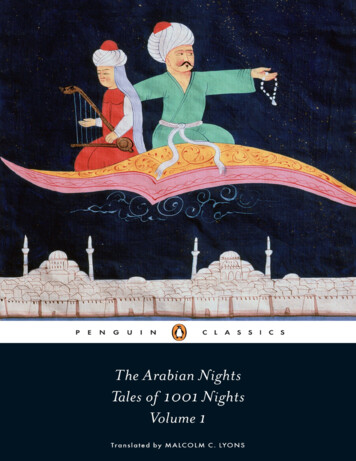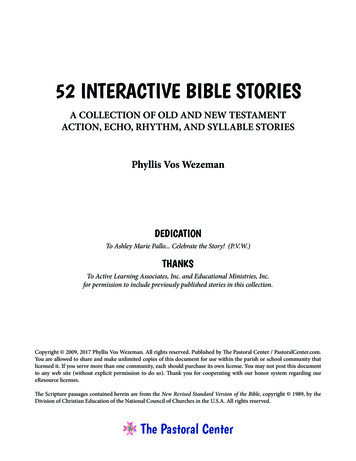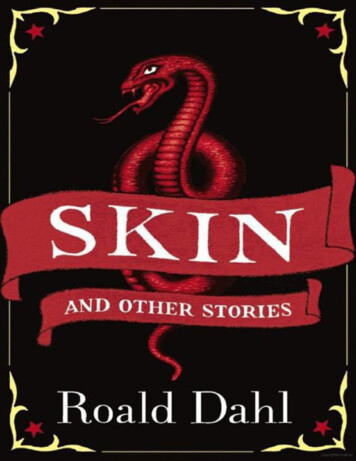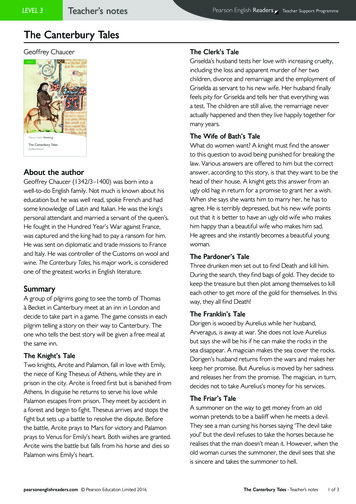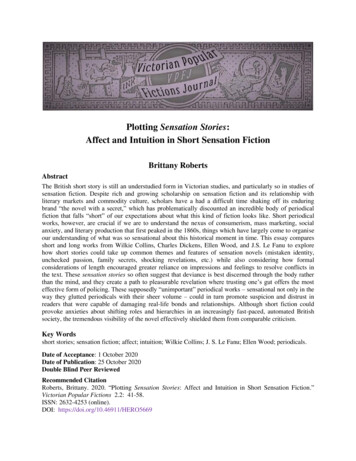
Transcription
Plotting Sensation Stories:Affect and Intuition in Short Sensation FictionBrittany RobertsAbstractThe British short story is still an understudied form in Victorian studies, and particularly so in studies ofsensation fiction. Despite rich and growing scholarship on sensation fiction and its relationship withliterary markets and commodity culture, scholars have a had a difficult time shaking off its enduringbrand “the novel with a secret,” which has problematically discounted an incredible body of periodicalfiction that falls “short” of our expectations about what this kind of fiction looks like. Short periodicalworks, however, are crucial if we are to understand the nexus of consumerism, mass marketing, socialanxiety, and literary production that first peaked in the 1860s, things which have largely come to organiseour understanding of what was so sensational about this historical moment in time. This essay comparesshort and long works from Wilkie Collins, Charles Dickens, Ellen Wood, and J.S. Le Fanu to explorehow short stories could take up common themes and features of sensation novels (mistaken identity,unchecked passion, family secrets, shocking revelations, etc.) while also considering how formalconsiderations of length encouraged greater reliance on impressions and feelings to resolve conflicts inthe text. These sensation stories so often suggest that deviance is best discerned through the body ratherthan the mind, and they create a path to pleasurable revelation where trusting one’s gut offers the mosteffective form of policing. These supposedly “unimportant” periodical works – sensational not only in theway they glutted periodicals with their sheer volume – could in turn promote suspicion and distrust inreaders that were capable of damaging real-life bonds and relationships. Although short fiction couldprovoke anxieties about shifting roles and hierarchies in an increasingly fast-paced, automated Britishsociety, the tremendous visibility of the novel effectively shielded them from comparable criticism.Key Wordsshort stories; sensation fiction; affect; intuition; Wilkie Collins; J. S. Le Fanu; Ellen Wood; periodicals.Date of Acceptance: 1 October 2020Date of Publication: 25 October 2020Double Blind Peer ReviewedRecommended CitationRoberts, Brittany. 2020. “Plotting Sensation Stories: Affect and Intuition in Short Sensation Fiction.”Victorian Popular Fictions 2.2: 41-58.ISSN: 2632-4253 (online).DOI: https://doi.org/10.46911/HERO5669
Victorian Popular FictionsVolume 2: issue 2 (Autumn 2020)Plotting Sensation Stories:Affect and Intuition in Short Sensation FictionBrittany RobertsIntroductionAn affluent, spirited young woman enters into a marriage with a man whose complexion is“naturally dark and swarthy” (Collins 1858 [2004]:178). Her former husband – a man twentyfive-years her senior – has recently died. Her not-affluent new husband is strongly disliked by thefamily’s most loyal and senior servant for inexplicable reasons, other than that he perceives inthe man a “rakish, unsettled look” and a “bounceable way of talking” (150). The new husbandproceeds to buy a yacht with his wife’s fortune, and shortly thereafter, departs to no-one-knowswhere after an intense verbal altercation with his wife over what is made clear to readers is aplatonic relationship between her and the village clergyman. An anonymous letter arrives. Themistress of the home and her lawyer confide in the faithful servant the secret of the letter, whichreveals that the husband has taken another wife, a fact witnessed by the writer’s own eyes. Aseemingly omniscient detective is brought in. A transnational pursuit takes place. Clues aregathered. The detective knows what has happened and predicts – to the loyal servant’samazement – what will happen with the case in the future. Bigamy, a staged murder, revenge,swooning, false imprisonment, asylums – but in the end, order and truth are restored.While this sensational plotline has all the makings of an 1860s triple-decker novel, all ofits mysteries are established and solved in a mere fifty-five pages. The story in question is WilkieCollins’s “A Marriage Tragedy” (1858),1 and it is a significant one because it offers an exampleof how writers of the mid-nineteenth century were producing thrilling narratives of modern timesin shorter forms that were raising the same kind of economic and social concerns as longersensation novels.The story, which originally appeared in the February 1858 edition of Harper’s, was later republishedunder the title “A Plot in Private Life” in Collins’s short story collection The Queen of Hearts (1859).1ISSN: 2632-4253 (online)41
Victorian Popular FictionsVolume 2: issue 2 (Autumn 2020)In this essay, I begin to outline how this long-neglected form adopts comparable themesand takes up similar questions as the well-studied novel but uses affect and intuition to differentnarrative ends within its framework of limited space. Like sensation novels, sensation storiesreinforce the idea that ordinary people hide extraordinary secrets that can make what wouldotherwise be a very mundane world a sensational one. They likewise respond to and posequestions about human identity and changing social structures, and they do so with narrativesthat promote excitement and suspense over mimetic realism. Unlike novels though, thebackground of the families or individuals involved tends to be outlined in mere sentences ratherthan chapters; indeed, often when we pick up one of these stories, we are dropped immediatelyinto the action. Comparing short and long works from Wilkie Collins, Charles Dickens, EllenWood, and J.S. Le Fanu reveals how short stories rely on a greater use of impressions andintuition to resolve the conflicts raised in the narrative. And while the reliance on intuition inthese stories may in some ways suggest that the novel was the form better positioned tochallenge ideological structures, short fiction was a marginalised, more “invisible” form thatcould invite greater risk-taking with endings that challenge the more conventional ones scholarshave come to associate with the very visible Victorian novel.2 It is not my intention in thefollowing examples to generalise a list of “essential” characteristics that all stories must possessto be included in the sensation genre. Rather, in heeding Dominic Head’s warning that anydefinition of a literary form must consider “prevailing tendencies rather than essential qualities”(1992: 3), I wish to highlight how these stories – like the novel that has historically defined thegenre – could provoke anxieties about shifting roles and hierarchies in an increasingly fastpaced, automated British society by staging shocking incidents as the cogs through which readersmust pass to get through the narrative.The Neglected Short StoryThe British short story is still an understudied form in Victorian studies, and particularly so instudies of sensation fiction.3 Despite rich and growing scholarship on sensation fiction and itsrelationship with literary markets and commodity culture, scholars have a had a difficult timeshaking off its enduring brand “the novel with a secret,” which has problematically discounted anincredible body of periodical fiction that falls “short” of our expectations about what this kind of2The widespread availability of short fiction in mid-century periodicals did not translate into the samekind of popularity – or sometimes notoriety – as the novel. The novel, as a key driver of magazine sales,would bear the brunt of critics’ censure. I have argued earlier that Mary Elizabeth Braddon’s story “Ralphthe Bailiff” (1861) provides a good example of a sensational short story that presents an ending that mayhave been too controversial for novel form (Roberts 2018). In it, the servant interlopers’ schemes golargely unpunished; they end up securing the family’s wealth for themselves and living as respectedcitizens in Australia.3Discussions of mid-nineteenth century short fiction have largely focused on the supernatural rather thanthe sensational. However, Dominic Head’s edited collection The Cambridge History of the VictorianShort Story (2016) is one recent effort to explore other genres of short fiction; in it, Sophie Gilmartin’s“The Victorian Pot-Boiler: Novelists Writing Short Stories” acknowledges the tendency of well-knownsensation authors to write similar kinds of content in short-story forms.ISSN: 2632-4253 (online)42
Victorian Popular FictionsVolume 2: issue 2 (Autumn 2020)fiction looks like.4 Short periodical works, however, are crucial if we are to understand the nexusof consumerism, mass marketing, social anxiety, and literary production that first peaked in the1860s, things which have largely come to organise our understanding of what was so“sensational” about this historical moment in time. At a time when literature was becomingincreasingly cheap, ephemeral, and formulaic, critics saw sensation fiction as a catalyst andsymptom of a new age of unthinking consumption and the key offender in the crime against highart and middle-class morality. As Harold Orel points out, short fiction published before the 1880swas looked upon by Victorian readers and magazine editors alike as mere “by-product,” or “fillermaterial” to the “central commodity” of the novel (Orel 1986: 2) – unimportant and oftenartistically flawed, with value that lay mostly in the entertainment the stories could provide in amoment of leisure. Short fiction as a burgeoning magazine form in Britain further supported thesense that a new market culture was effecting a shift in values that was radically changing theterms of “important” literature.In addition to these sensational changes in the literary market that informed the shortstory’s rise in Britain, short periodical fiction offered no shortage of sensational content (and insome cases content that was even more explicit and shocking than even the most criticisednovels). Yet, given the strong association of sensation fiction with heavily plotted novels,sensation stories have received little scholarly attention. While there have been some recentattempts to expand what kinds of works “qualify” as sensation fiction and how those worksmight complicate our understanding of this historical moment of intense and rapid change, suchefforts have been sporadic and inconsistent. Edited collections of criticism like KimberlyHarrison and Richard Fantina’s Victorian Sensations: Essays on a Scandalous Genre (2006),Pamela Gilbert’s Blackwell Companion to Sensation Fiction (2011), and Andrew Mangham’sThe Cambridge Companion to Sensation Fiction (2013) emphasise a need to expand the genreparameters and timeline of sensation fiction, and each collection includes contributions thatmake an effort to do so,5 but to date, there is still a real need for a comprehensive study of how4We have taken our cue from nineteenth-century critics and moral crusaders whose censure of thesepopular works of crime and deviance was aimed specifically at sensation novels and novelists. KathleenTillotson coined the term “novel with a secret” as a way of organizing the body of work that comprisedthe “lighter reading of the eighteen-sixties” in her introductory remarks to Wilkie Collins’s The Woman inWhite in 1969 (1969: xv). Later, in The Maniac in the Cellar, Winifred Hughes identifies “the sensationnovel” as a unique and recognizable genre that “exploded on the literary scene” in the early 1860s andcontributed to the “national state of mind known as ‘Sensation Mania’” (1980: 5). By the time of PatrickBrantlinger’s 1982 article, “What is ‘Sensational’ about the ‘Sensation Novel’?” the strong association ofsensation fiction with the novel was becoming well-established.5In Victorian Sensations: Essays on a Scandalous Genre, Harrison and Fantina contend that a keypurpose of their collection is to “expand the limits of the sensation genre” (2006: xi), but only one essayactually engages a work that is not a novel: Nancy Welter’s article “Women Alone: Le Fanu’s ‘Carmilla’and Rossetti’s ‘Goblin Market.’” Five years later, the Blackwell Companion to Sensation Fiction made astronger attempt to posit forms outside of the novel as important to the genre. Indeed, as one reviewer ofthe collection writes, it is “particularly pleasing to see illustration [ ] poetry, and short fiction[represented]; these are significant areas of research that are not readily associated with sensation fiction,a genre still very much linked to the novel” (O’ Brien Hill 2011). In The Cambridge Companion toSensation Fiction, Anne-Marie Beller’s article “Sensation fiction of the 1850s” does a notable job of notonly expanding sensation beyond the 1860s but of revealing how novels written by popular sensationauthors in the 1860s were sometimes derived from short stories these authors had developed in the 1850s.Still, even with these attempts at inclusivity, the Blackwell Companion as well as the CambridgeISSN: 2632-4253 (online)43
Victorian Popular FictionsVolume 2: issue 2 (Autumn 2020)short fiction functioned – as a primarily ephemeral form – in an age marked and consumed byfears of “meaningless” consumption driven by bodily desire.To push our thinking about the sensation genre beyond the novel is necessary when weconsider how much of the reading done in this sensational moment in history was of these“filler” stories that were appearing in popular periodicals. The number of periodicals publishedbetween 1824 and 1900 exceeds fifty thousand (Orel 1986: 3), and for much of the nineteenthcentury, the short story in Britain was primarily a magazine form. While certainly not allperiodicals were successful or popular, Dennis Denisoff has argued that “short fiction was beingconsumed by millions from all classes, age groups, and literacy levels,” which “made it socommon as to be invisible, and so popular as to be seen as unworthy of the exclusivenessassociated with scholarly recognition” (2004: 17). His observation is particularly true for shortfiction written before the last two decades of the century, before, as Andrew Maunder writes, theshort story “came into its own” as a genre (2007: viii).Recent studies of British short fiction in the periodical press, though still few in number,increasingly highlight the short story’s relative invisibility as an artefact of mass production andwhat that might mean for writers whose stories could, essentially, hide in plain sight. JochenAchilles and Ina Bergmann, for example, hint at this paradox in Liminality and the Short Story:Boundary Crossings in American, Canadian, and British Writing (2015) when they discuss thepiratical impulse in British periodical publishing to take and rework (and more often, flagrantlyplagiarise) short stories. Certain narratives, they argue, could become known and easilyrecognised without having any discernible origin (stories could even appear on differentcontinents under different names); they could be everywhere and yet nowhere in particular,present but not “standing out.” Kate Krueger, on the other hand, sees this (in)visibilitydifferently, arguing in British Women Writers and the Short Story, 1850-1930 (2014) that theinvisibility of short stories aligns with women’s invisibility as important producers of culturalknowledge, even though both the stories and the women who produced them were not difficult tofind. Indeed, it is well-documented that women contributed substantially to the body of shortfiction published in the nineteenth century, and Krueger’s position that short fiction could offerfemale writers a “venue in which to represent their alienation from dominant ideologies” isechoed particularly in feminist projects of Victorian ghost stories (2014: 3-4).6 In an attempt topull short fiction out of the proverbial shadow, works like Liggins, Maunder and Robbins’s TheBritish Short Story, Amanpal Garcha’s From Sketch to Novel: The Development of Fiction, andeven Brigham Young University’s Victorian Short Story Project7 testify to a growing interest inBritish short fiction produced before the final decades of the century; however, none of thesehave considered with any depth how the form evolved amid and contributed to “SensationCompanion that appeared two years later are necessarily limited in how much space they can devote toforms outside of the novel in collections that seek to explore Victorian sensation broadly.6Examples include Vanessa D. Dickerson’s Victorian Ghosts in the Noontide: Women Writers and theSupernatural (1996), Diana Wallace’s “Uncanny Stories: The Ghost Story as Female Gothic” (2004), andMelissa Edmundson Makala’s Women’s Ghost Literature in Nineteenth-Century Britain (2013).7The Victorian Short Story Project is a collaborative digital archiving venture designed by the studentsand faculty at Brigham Young University. Stories published throughout Victoria’s reign are hosted foreasy access in an effort to offer a broader sense of what the Victorians were consuming in their “everydayreading” and encourage “study of the nineteenth-century short story” (“Main Page”). The stories varywidely in theme and intended audience, but all fall under fifty pages in length.ISSN: 2632-4253 (online)44
Victorian Popular FictionsVolume 2: issue 2 (Autumn 2020)Mania,” a time when the appearance of things most inspired scepticism. And yet the evidence ofan important connection between short fiction and sensation is, as all-star detective SergeantCuff tells his bewildered companion in The Moonstone, “as plain as the nose on your face”(Collins [1868] 1999: 181). Though the novel has played an important role in organizing ourunderstanding of sensation fiction and the literary market in the nineteenth century, it hassubsequently hidden the short story from view.Comparing Sensation Novels and Short StoriesSensation novels and sensation short stories have a lot in common, even though these novels areknown for their long, labyrinthine plots. Both use shocking incidents as a way of calling intoquestion social hierarchies and institutions, the role of women, and the belief in the family as thesolid foundation upon which British life could be comfortably situated. Both are also centrallyconcerned with questions of identity – if people are not who they appear to be, then who are theyreally? The plots, which generally move toward a climactic revelation in response to the text’smysteries, habitually focus on policing deviant agents, which often includes an investigator ofsome sort (usually an amateur detective associated with the family in some way). Though formalinvestigations are common, behaviours are policed and disciplined using all sorts of mechanismsin these stories, and shocking crimes, excessive passions, and cruel schemes – all taking placeright at home on the domestic hearth – characterise the sensation novel as well as sensationalshort stories.Understandably though, for short stories, fewer staged moments of “mini climax” serveto move the plot towards its inevitable denouement, making the trajectory of revelation moredirect. While both sensation stories and novels suggest that there are deviant persons at hand whoneed to be watched and decoded, the stories are considerably more intentional than are the novelsin alerting readers to underlying corruption. These differences – a more direct path to revelation,which is made possible by (ultimately) sound assumptions about who the deviant agent is – aresignificant for what they suggest about how people can access knowledge about others and theworld in which they live.Intuition and “gut reactions” feature prominently in both sensation novels and stories, butwhere one presents these as a “puzzle” in need of a careful collection and examination of clues torationalise the “solution,” the other suggests the solution is already waiting to be found withinone’s feelings. Because of the shorter length of these stories, the plot is often activated by acharacter’s (often the first-person narrator’s) intense feelings of mistrust or dread toward anothercharacter or situation, and his or her emotional reactions imbue otherwise ordinary circumstanceswith meaning. Sensational short stories, it seems, diverge from novels in their suggestion thatdeviance is better discerned through the body than the mind. Plotting these affective cues withina limited narrative frame propels readers towards a foreseeable end, and in doing so, also modelsto great benefit how bodily response might serve to gauge duplicity more effectively than reason.These stories insist that the way one parts one’s hair, the manner and tone of one’s laugh, or anyother innocuous detail of one’s personal appearance very likely signifies an evil heart – if onefeels like it does.88Impressions are important in sensation novels, but they are frequently misleading. For example, RobertAudley is wrong in many of his assumptions about what happened to his missing friend in Lady Audley’sISSN: 2632-4253 (online)45
Victorian Popular FictionsVolume 2: issue 2 (Autumn 2020)It is precisely this kind of suspicion that critics like Henry Mansel feared when theywarned about the moral dangers of sensation novels. Mansel writes, for example, that readersmay be “thrilled with horror” in imagining that the “pleasing outsides” of the good peoplearound them could be concealing “some demon in human shape,” but, he warns, “we may bepermitted to doubt whether the pleasure of a nervous shock is worth the cost of so much morbidanatomy if the picture be true, or so much slanderous misrepresentation if it be false”(1863: 489). He acknowledges, “there is satisfaction in exposing an imposter” (513), and theseshort stories promise readers this satisfaction by engaging them in a fantasy where firstimpressions point to some sort of truth, for as Susan Lohafer has convincingly argued,“short fiction [ ] is the most ‘end conscious’ of forms [and] readers of short fiction are the most‘end-conscious’ of readers” (1984: 94). Indulging in such fantasies, however, could potentiallyimpair, if not fracture, households, communities, and potentially, an entire nation, as anyone andeveryone can be a suspect in a society where special talent, tools, and evidence are optional inbringing about “justice.”Wilkie Collins as Storyteller and Story WriterIn thinking about what constitutes a sensation story, it makes sense to begin with the abundantoeuvre of Wilkie Collins, who is generally regarded as the founding father of the sensationnovel. Despite growing interest in Victorian Sensation and increasingly comprehensive studies ofits impact on nineteenth-century British society (and beyond), and even with Wilkie Collins’sreputation as an early architect of the genre, Collins’s short fiction has received only marginalcritical attention. His short fiction appears to have become a casualty in sensation scholarship tohis well-known novels and in British short story scholarship to the persistent idea that the “real”stories of merit did not emerge until the end of the nineteenth century. Acknowledging this gap,John Bowen writes that Collins’s shorter fiction deals with much “disturbing or uncanny materialthat cannot easily be assimilated or found a home,” and he suggests that while the stories “sharemany qualities with his novels,” they are also “significant and distinctive texts in their own right”(2006: 36-7). It is worth noting that while Collins produced many short stories over the course ofhis forty-plus-year career, the number of stories drops significantly during the 1860s,9 his mostproductive decade of novel writing. Still, many of his stories published in the surroundingdecades, particularly those of the 1850s, bear strong similarities to the novels that helped makehim a celebrated author.In a fascinating unsigned review of Collins’s short story collection The Queen of Hearts(1859), a key link between sensation stories and novels emerges: the importance of story-telling.What begins as an attempt to review the merit of Collins’s stories repeatedly, and ironically,turns into a treatise on the function of a novel writer, a slippage which has the effect of blurringdistinctions between the forms in an important way:Secret. The Moonstone is filled with faulty ideas about who has stolen the diamond (and notably, theservant class unfairly bears the brunt of this suspicion). Betteredge, in particular, is entirely wrong in hisintuitive dislike and distrust of Ezra Jennings. And who would have guessed that the good-naturedProfessor Pesca would be the nemesis of the evil Count Fosco in The Woman in White?9Only three known stories were produced by Collins in this decade, all published in 1861 in All the YearRound: “Memoirs of an Adopted Son,” “The Cauldron of Oil,” and the “Fatal Cradle” (originallypublished as “Picking up Waifs at Sea” as part of Tom Tiddler’s Underground in the Christmas edition).ISSN: 2632-4253 (online)46
Victorian Popular FictionsVolume 2: issue 2 (Autumn 2020)Both in his preface and in the body of work, Mr. Collins invites the reader to observe whatis the object which the author has set before him in composing the series of tales collectedunder the name of the Queen of Hearts. What Mr. Collins aims at is being a story-teller. Hewishes to construct a narrative the effect of which shall be to awake, sustain, and satisfythe interest of the reader. There are plenty of novels written in these days to unfold thephilosophy or to instil the instruction which finds favour with the writer. There are novelsin which the author attempts to elaborate character [ ] novels intended to describe statesof society which have passed away, or ways of life unfamiliar to the English public [ ]Mr. Collins considers that all these attempts are divergencies from the proper duty of anovelist. A story-teller should have a story to tell, and should tell it. It is his business not toimprove or instruct mankind, but to amuse.(Rev. of The Queen of Hearts, Saturday Review [1859] 1974: 74)While the short story is the form more readily brought to mind when thinking about oraltraditions of story-telling,10 the repeated emphasis on the idea that “telling” a story is whatCollins would consider the “proper duty of a novelist” implies the ongoing influence of thistradition at the heart of both of these forms, which is, as Henry Orel suggests, a tradition that“acknowledge[s] the presence of an audience, [while placing] an emphasis on colorful incidentand verbal exaggeration” (1986:14). The idea that Collins is primarily a “story-teller” is one thatreverberates in reviews of his long fiction throughout his most productive years of novel writing,with write-ups of The Woman in White (1859) indicating that “Mr. Wilkie Collins is anadmirable story-teller” (Rev. of The Woman in White, Saturday Review [1860] 1974: 83), ofArmadale that “He is a pure story teller” (“Recent Novels”, 1866: 107), and of The Moonstonethat “He is emphatically a story-writer” (Rev. of The Moonstone. Lippincott’s [1868] 1974: 180).As the last (and latest) review implies, Collins was able to translate the imperatives of storytelling to a written form in a way that was so successful that it could keep a nation of anxiousaudience members waiting for more. Sensation fiction, after all, has long been distinguished forthis unapologetic emphasis on plot.“A Marriage Tragedy”To return then to Collins’s story “A Marriage Tragedy,” the resemblance it bears to sensationnovels of the 1860s is clear just in the brief synopsis of the storyline in the opening lines of thisessay. Peter Haining has argued that the story bears resemblance to The Woman in White in that a“complicated family conspiracy” activates the plot, and the villainous husband of the short story,James Smith, bears a “striking resemblance” to the “evil-hearted” Percival Glyde of the novel(Haining 204: 20). It is worth pointing out that Collins might have had “A Marriage Tragedy” inmind when he began work on The Woman in White, as there appears to be a reference made to itin the early pages of the novel during Hartright’s first encounter on the road with the mysteriouswoman in white. When she asks him to name the Baronets that he knows, Hartright responds thatone was a “bachelor who had once taken [him] on a cruise on his yacht” (Collins [1859] 1998:24). In the short story, James Smith’s yacht, which he buys immediately after marrying hiswealthy wife, is a symbol of greed and excess, one that makes him immediately suspicious to theloyal servant who narrates the story. That he would cruise around on it under the guise of a10Ghost stories in particular have a strong association with orality. Frequently, for example, they beginwith a narrator engaging with an audience of avid listeners as they gather around the winter hearth.ISSN: 2632-4253 (online)47
Victorian Popular FictionsVolume 2: issue 2 (Autumn 2020)“bachelor” makes sense for a man in search of an additional wife, and the reference is a suitableone in these early pages of the novel, as Hartright – along with readers – is being asked tospeculate about identity for the first time, particularly in associating secrets and vice with peopleof rank and title.11 The story in some ways helps establish a trope that permeates many sensationnarratives: people are rarely who they seem to be, and those who recognise this point will be bestequipped to protect themselves against deception.Although Haining sees the influence of “A Marriage Tragedy” most readily in TheWoman in White, the story also bears several similarities to The Moonstone, which are worthconsidering at length to get a better sense of some of the larger preoccupations of sensationstories more generally. Not only does the short story feature missing jewels and supply a bloodstained nightgown as a precursor to the novel’s paint-stained one,12 but it also places familysecrets at the centre of an investigation while making use of narrative techniques that alignreaders with an amateur
short and long works from Wilkie Collins, Charles Dickens, Ellen Wood, and J.S. Le Fanu to explore how short stories could take up common themes and features of sensation novels (mistaken identity, unchecked passion, family secrets, shoc






